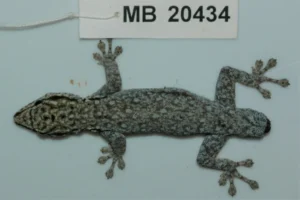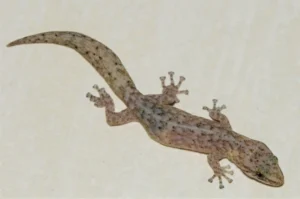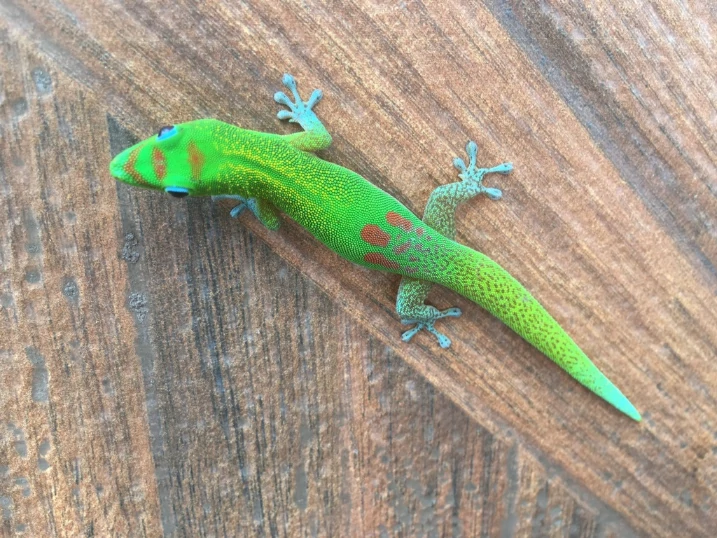Have you ever seen a lizard dash across the ground and suddenly notice its tail wiggling on its own while the rest of the body is long gone?
It’s one of those little survival tricks that can really catch you off guard the first time you see it. The tail keeps twitching, sometimes for several minutes, while the lizard disappears into a crack or under a bush.
It almost looks like the tail has a mind of its own. But does this mean every lizard can do this? Can all lizards drop their tails when they’re in danger?
No, not all lizards can drop their tails, but many of them can. Tail-dropping is a survival strategy found in a lot of lizard species, especially those that rely on running and hiding to escape predators. However, some lizards don’t have this ability at all, and others can only drop part of their tail under certain conditions. Basically, whether a lizard can autotomize depends on the species and how its body is built.
Tail-dropping is more common in certain lizard families, usually smaller species that are more at risk from predators. For example, many geckos, skinks, and anoles are famous for it.
But bigger lizards, like iguanas or monitor lizards, usually can’t drop their tails. So even though you might picture every lizard leaving its tail behind in a dramatic escape, that’s not really how it works.
Why Some Lizards Drop Their Tails
The reason is simple: survival. When a predator grabs a lizard, having a tail that can detach gives the lizard a second chance. This is called tail autonomy
The predator focuses on the wiggling tail, giving the lizard a chance to escape.

The tail doesn’t just flop around, it moves in a way that keeps the predator distracted, increasing the lizard’s chances of getting away.
The tail isn’t just a decoy, though. In some lizards, the tail stores fat and nutrients. Losing it isn’t without cost.
A lizard that drops its tail might escape, but it now has less energy stored for growth, reproduction, or surviving tough conditions.
Tail-dropping is like an “emergency option,” not something they do for fun.
Some lizards can drop their tails in specific segments, called fracture planes. These are areas where the tail can break off easily if needed.
The lizard doesn’t have to be grabbed fully; a strong tug or a predator bite can trigger it. Other lizards don’t have these planes, so their tails are firmly attached and can’t be shed without serious injury.
Which Lizards Can Drop Their Tails?
If you’re wondering who the champions of tail-dropping are, geckos are a great example. Many gecko species can lose their tails almost instantly.

A predator grabs the tail, and seconds later, the lizard is gone, leaving a wiggling stump behind. Skinks are also well known for this.
Some skinks can even regrow their tails multiple times, though the new tail often looks different, sometimes squarer or with less color.
Anoles, smaller lizards, use tail-dropping too. In these little guys, the tail can keep twitching for minutes after the lizard has run away.
It’s almost like the tail is putting on a little show to distract predators while the lizard vanishes.
Big lizards, like iguanas, monitors, and chameleons, rarely drop their tails. Their tails are heavy, strong, and important for balance and movement.
Losing a tail would cost them too much. Instead, they rely on speed, camouflage, biting, or even powerful tail whips to escape danger.
Here’s a quick look at some common lizards and whether they can drop their tails:
| Lizard Species | Can They Drop Their Tail? | Tail Regrowth Time | Notes |
|---|---|---|---|
| Green Anole (Anolis carolinensis) | Yes | 4–6 weeks | Tail drops easily; regrown tail often shorter |
| Brown Anole (Anolis sagrei) | Yes | 4–6 weeks | Common in gardens; tail wiggling distracts predators |
| Leopard Gecko (Eublepharis macularius) | Yes | 8–12 weeks | Popular pet; tail may change color when regrown |
| House Gecko (Hemidactylus spp.) | Yes | 3–6 months | Tail-dropping is a defense against predators |
| Skinks (e.g., Blue-tailed Skink, Plestiodon spp.) | Yes | Several months | Can drop segments; new tail darker or smoother |
| Bearded Dragon (Pogona vitticeps) | No | N/A | Tail is used for balance and defense |
| Green Iguana (Iguana iguana) | No | N/A | Tail helps with balance, swimming, and defense |
| Monitor Lizard (Varanus spp.) | No | N/A | Large and muscular; tail is a weapon |
| Chameleons (Chamaeleonidae) | Some species limited | Varies | Small species can drop tips; most can’t drop full tail |
| Five-lined Skink (Plestiodon fasciatus) | Yes | 2–3 months | Juveniles have bright blue tails that distract predators |
| Common Wall Lizard (Podarcis muralis) | Yes | 2–4 months | Tail drops when grabbed; regrown tail is duller |
| Eastern Fence Lizard (Sceloporus undulatus) | Yes | 6–8 weeks | Tail acts as a decoy; common in eastern US |
| Mediterranean House Gecko (Hemidactylus turcicus) | Yes | 3–4 months | Tail-dropping occurs when threatened; common in urban areas |
| Tokay Gecko (Gekko gecko) | Yes | 3–6 months | Large gecko; tail can regrow but may be blunt |
| Australian Blue-tongue Skink (Tiliqua scincoides) | No | N/A | Tail thick and strong; used for fat storage and defense |
| Crested Gecko (Correlophus ciliatus) | Yes (partial) | 3–4 months | Can drop tail tips but not entire tail; tail does not fully regrow |
| Mediterranean House Lizard (Podarcis siculus) | Yes | 2–3 months | Agile climber; tail used to distract predators |
| Desert Horned Lizard (Phrynosoma platyrhinos) | No | N/A | Tail is short and spiny; relies on camouflage for defense |
| Gila Monster (Heloderma suspectum) | No | N/A | Venomous; tail used for fat storage and balance |
| Frilled Lizard (Chlamydosaurus kingii) | No | N/A | Tail used for balance during running and displays |
This table shows that tail-dropping isn’t universal. Most geckos, anoles, and skinks can do it, while bigger lizards like iguanas and monitors rely on their strong tails instead.
Even among lizards that can drop tails, the ability varies; some can only drop the tip or certain segments.
How Long Does It Take for a Lizard’s Tail to Grow Back?
One of the coolest parts of tail-dropping is regrowth. Not every lizard can regrow its tail, but those that can go through an amazing process.

The new tail isn’t an exact copy of the old one. It may have a simpler bone structure, look different in color or texture, but it still works for balance and distraction.
The time it takes to grow a new tail depends on species, age, and health. Younger lizards grow faster.
Here’s a rough guide for some common tail-regrowing lizards:
| Lizard Species | Tail Regrowth Time |
|---|---|
| Leopard Gecko | 6–12 months |
| Green Anole | 2–3 months |
| Blue-Tongue Skink | 4–6 months |
| Common House Gecko | 3–6 months |
| Five-Lined Skink | 3–4 months |
A new tail is usually weaker than the original. It can still distract predators and help with balance, but it won’t have the same fat stores or strength.
Can You Prevent a Lizard From Dropping Its Tail?
Pet owners often ask this. No one wants to see their gecko or skink lose a tail, because it stresses the animal and slows growth.
Tail-dropping usually happens when the lizard is stressed or injured. So the best way to prevent it is to reduce stress and handle lizards carefully.
Here’s how:
-
Handle gently – never grab a lizard by its tail.
-
Provide hiding spots – lizards feel safer when they have places to retreat.
-
Avoid overcrowding – fights or rough interactions can cause tail loss.
-
Keep the environment stable – sudden temperature changes or loud noises can stress lizards.
Basically, if a lizard feels safe and calm, it’s much less likely to drop its tail. In the wild, tail-dropping is part of life.
Predators won’t wait politely, so shedding a tail can literally save a lizard’s life.
Why Don’t All Lizards Drop Their Tails?
Tail-dropping is clever, but it’s not for every lizard. Big lizards need their tails for balance, swimming, or defense.
Some rely more on speed, camouflage, or strong scales. Evolution only favors tail-dropping when the benefits outweigh the cost.

For small lizards, losing a tail is a temporary setback that can save their life. For a big iguana, losing a tail could mean serious injury or trouble moving, so nature didn’t favor this trick in big species.
Sometimes tail-dropping is just too expensive. Tails store fat, which is very important for surviving tough times.
Losing it would be like burning your savings to escape a small threat; not always worth it.
Interesting Facts About Lizard Tails
Lizard tails aren’t just for show. Here’s what they do:
-
The tail can keep twitching for minutes after it’s detached, thanks to reflexes in the nerves. It’s literally the lizard’s last stand against predators.
-
Some lizards store fat in their tails, which helps them survive when food is scarce. Losing the tail means losing energy.
-
Regenerated tails are often made of cartilage instead of bone and are usually less colorful than the original.
-
Tail-dropping is costly, so lizards only do it in emergencies. They prefer running, hiding, or blending in first.
These facts show that tails are an essential tool for lizards, not just a backup for danger.
When Tail Dropping Goes Wrong
Tail-dropping is impressive, but it has risks. A detached tail can get infected, and the lizard might struggle to escape a second predator without it. In captivity, stress or rough handling can trigger unnecessary tail loss, which can slow growth or affect health.
Sometimes pet lizards drop their tails even without being grabbed. This happens when they feel cornered or threatened. That’s why it’s so important to keep them in a calm, safe environment.
Conclusion
So, do all lizards drop their tails? Not at all. Tail-dropping is a clever survival trick, but it’s only in certain species like geckos, skinks, and anoles.
Bigger lizards, like iguanas and monitors, usually can’t do it because losing a tail would be too costly.
For lizards that can shed their tails, it’s an amazing strategy. The tail distracts predators, the lizard escapes, and in many cases, the tail can regrow.
But it’s not free. Losing a tail costs energy, fat stores, and sometimes mobility. It’s a last-resort option, not something a lizard does casually.
If you see a lizard with a missing or regrown tail, now you know the story. That little wiggling stump is a testament to survival, clever defense, and the ways animals protect themselves.
And while not all lizards have this trick, those that do rely on it to survive in a world full of predators, danger, and unexpected encounters.
Hi, my name is Ezra Mushala, i have been interested animals all my life. I am the main author and editor here at snakeinformer.com.

